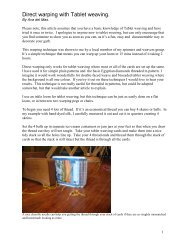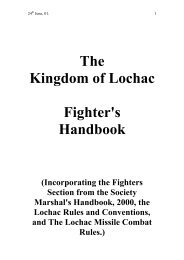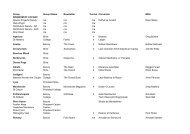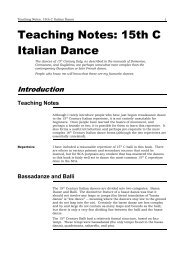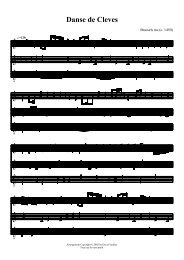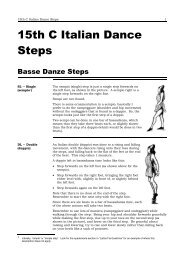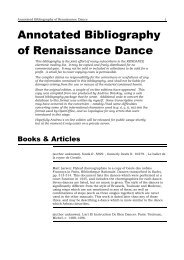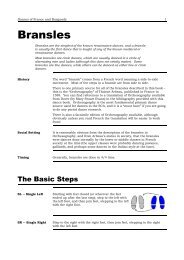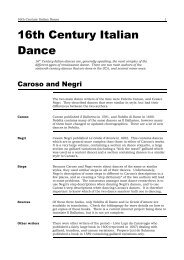Kingdom of Lochac Combat Handbook - SCA Ltd (Australia)
Kingdom of Lochac Combat Handbook - SCA Ltd (Australia)
Kingdom of Lochac Combat Handbook - SCA Ltd (Australia)
Create successful ePaper yourself
Turn your PDF publications into a flip-book with our unique Google optimized e-Paper software.
16 CHAPTER 4. CONVENTIONS OF COMBAT4.3 Rules <strong>of</strong> Engagement4.3.1 Unit engagement1. Unit engagement happens when two or more coherent units <strong>of</strong> opposing heavy combatants meet in combat.2. In unit engagement, all combatants who are part <strong>of</strong> each unit are considered to be engaged with all combatantswho are part <strong>of</strong> <strong>of</strong> the other unit(s).3. In unit engagement combatants who are part <strong>of</strong> a unit may strike at members <strong>of</strong> opposing units, who are totheir front or side, without being considered to be “behind” or on their “blind side”.4. If a unit loses coherency, combatants from that unit are considered to have left the unit engagement and mustbe engaged as an individual, as per the “Individual engagement” rules below.5. In any circumstance other than that outlined in 4.3.2.4, striking an opponent from behind is cause for ejectionfrom the field, and may be cause for further disciplinary action.4.3.2 Individual engagement1. In tournament melee combat, a combatant shall engage their opponent by moving into the line <strong>of</strong> sight <strong>of</strong> theopponent they wish to engage and stating loudly “my lord/lady I am engaging you” or words to that effect.2. In war combat, a combatant shall engage their opponent by moving into range in clear sight <strong>of</strong> the opponentthey wish to engage and adopting an attacking posture. If a combatant has reason to believe that theiropponent may not have seen them approach they should verbally engage them as per the procedure above.3. It is forbidden to strike at an opponent with whom you are not engaged.4. A combatant who turns their back on an opponent with whom they are engaged while remaining withinweapons range is subject to being struck by that opponent until they leave weapons range.4.3.3 Missile weapon and siege engine engagement1. All missile combatants and siege engine operators are considered to be engaged with all other combatants.Missile blows may be struck from any angle and regardless <strong>of</strong> the opponent’s awareness <strong>of</strong> the missilecombatant or siege engine.2. While missile and siege combatants are considered engaged with all other combatants, they themselves mustbe explicitly engaged as individual combatants.4.4 Killing Conventions4.4.1 Heavy combatants killing heavy combatants1. Heavy combatants will kill other heavy combatants with whom they are engaged by delivering a “good”blow with their weapon to a killing target area on their opponent. Target areas are detailed in chapter 6 onpage 23.2. <strong>Combat</strong>ants who note that their own blows strike with anything other than the striking surface should call“Haft!” or “Flat!” as appropriate to their opponent.3. In war scenarios heavy combatants may kill heavy combatants with whom they are not engaged by using the“killing from behind” manoeuver as detailed in section 4.4.5 on page 18.Date : 2007/06/2109 : 43 : 49RCS f ile : f ighters − handbook − 2.lyx,v Revision : 1.4The <strong>of</strong>ficial version <strong>of</strong> this document is available at http://www.sca.org.au/marshal/ Photocopied or printed editions <strong>of</strong> this document are notcontrolled.



